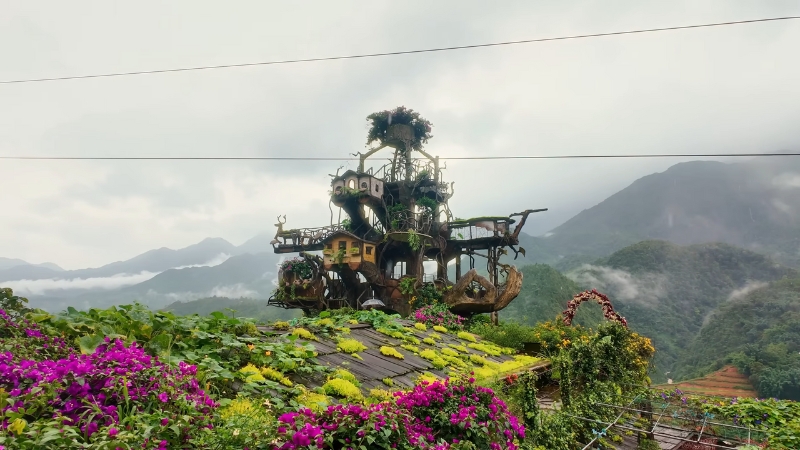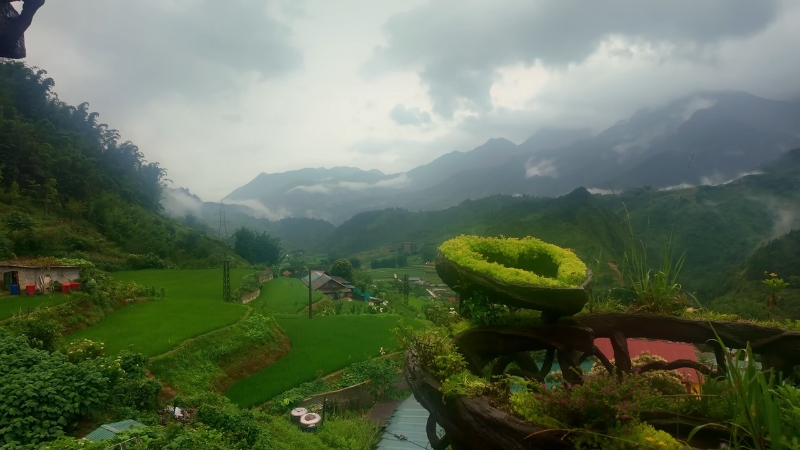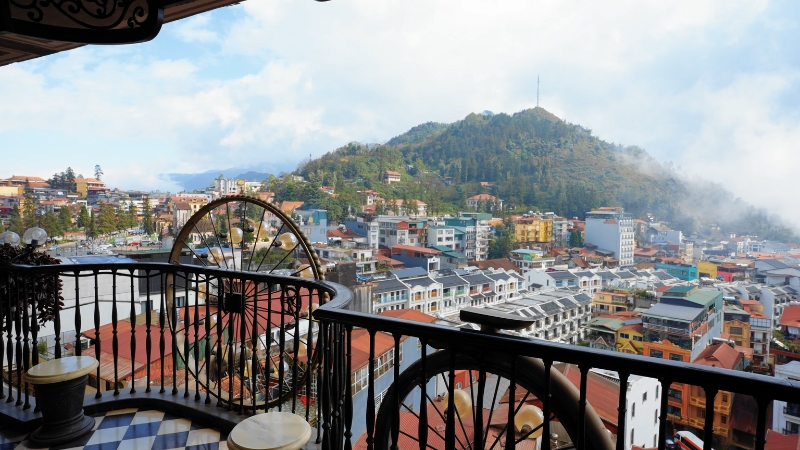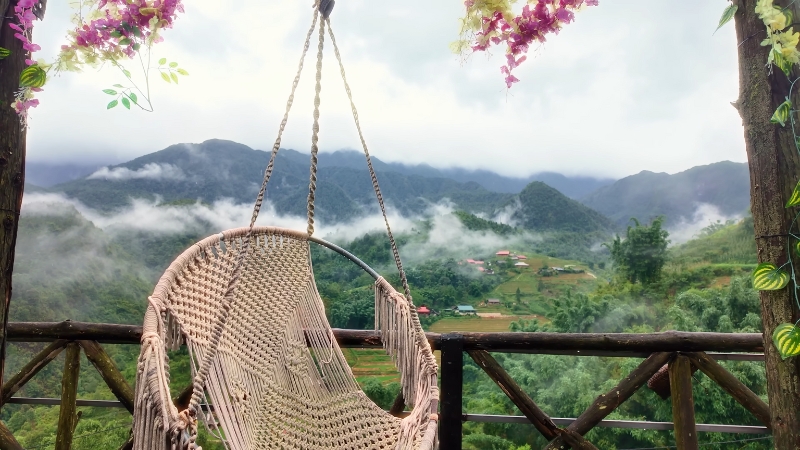The morning mist clings to the mountainside like a secret waiting to be whispered. I’m standing on a ridge overlooking the Muong Hoa Valley, watching a Hmong grandmother navigate terraces that have been carved into these slopes for over 700 years.
She moves with the confidence of someone who knows every stone, every curve of these ancient steps. This is Sapa at 6 AM – raw, authentic, and completely yours before the day-trippers arrive from Hanoi.
After seven seasons exploring Vietnam’s northern highlands, I’ve learned that timing isn’t just about weather in Sapa; it’s about discovering the soul of a place that changes personality with every shift of light and season.
When the Mountains Reveal Their Secrets
According to Vietnam’s National Tourism Administration, “the optimal visiting period spans March through May and September through November, when atmospheric conditions favor both agricultural beauty and outdoor activities.” But here’s what those official statistics don’t tell you: September mornings in Sapa feel like walking through liquid gold.
I remember my first September dawn trek to Y Linh Ho village. The rice terraces stretched below like hammered metal catching the first light, each terrace reflecting the sky in perfect stillness.
Local photographer Nguyen Van Duc, who’s documented these valleys for two decades, once told me: “September and October transform our mountains into nature’s cathedral, the rice turns golden just as the morning fog lifts, creating photographs that exist for only minutes each day.”
The harvest season brings something magical beyond the visual spectacle. Families work together in the fields, their laughter echoing across valleys as children help gather rice stalks.
This is when village life becomes most visible, most authentic. Temperatures hover around 15-20°C during the day, perfect for trekking without the summer heat that can make valley walks grueling by noon.
Spring months offer different rewards entirely. According to meteorological data from the Sapa Weather Station, “April and May provide the clearest atmospheric conditions, with visibility exceeding 20 kilometers on 70% of days.”
Translation: Fansipan Mountain reveals itself in all its 3,143-meter glory, and those cable car rides become worth every dong.
But here’s my insider tip based on seven years of seasonal visits: arrive in late March. The weather is stable, the spring blooms are just beginning, and you’ll beat both the April rush and the summer rains. Hotel rates remain reasonable, and local guides have more flexibility in their schedules.
Beyond the Standard Itinerary

According to cultural anthropologist Dr. Sarah Henderson from the University of Queensland, who spent three years studying ethnic communities in northern Vietnam: “Authentic cultural exchange in Sapa occurs in the spaces between organized activities, in shared meals, unexpected invitations, and moments when tourism fades into genuine human connection.”
The Fansipan cable car gets all the attention, and yes, those 15 minutes suspended above clouds are spectacular. But my most profound Sapa moment happened 2 kilometers away in Cat Cat Village, sharing corn wine with a Hmong family who invited me to their daughter’s naming ceremony.
The 70,000 VND village entrance fee bought me access to a world most tourists photograph but never experience.
Here’s what changed my perspective on Sapa trekking: forget the predetermined routes. Local guide Vang Su, from the Black Hmong ethnic group, taught me that the best trails aren’t marked on any map.
“Tourists follow paths,” he said, leading me through a forest that opened onto terraces I’d never seen in photographs. “But the mountains have stories in places where no tourists go.”
Ta Phin Village showcases this perfectly. Twelve kilometers from Sapa town, this Red Dao community offers something most visitors miss entirely: traditional medicine workshops. I spent an afternoon learning about herbal treatments that have been passed down for generations.
Village elder Ma Thi Gao explained: “Each plant in these mountains has a purpose, has power. But you must know when to pick, how to prepare, how to respect.”
The Saturday market in Ta Phin transforms the village into something extraordinary. According to local merchant records, over 200 families from surrounding hills converge here weekly, creating a cultural exchange that predates any tourist infrastructure.
Silver jewelry catches morning light while indigo-dyed fabrics display techniques unchanged for centuries.
Trekking Routes That Transform Perspectives
View this post on Instagram
Muong Hoa Valley offers what seems like an easy 8-kilometer walk until you realize you’re traversing a landscape that National Geographic photographer Michael Yamashita called “one of Asia’s most photographed yet least understood ecosystems.” The trail follows ancient water buffalo paths, each turn revealing terraces that represent generations of engineering genius.
According to agricultural engineer Dr. Le Minh Duc from Hanoi Agricultural University, “Sapa’s rice terrace system demonstrates sophisticated water management that modern irrigation struggles to replicate. These terraces have maintained soil fertility for over 700 years without chemical intervention.”
Walking these paths early morning, you witness this engineering in action. Water flows from terrace to terrace in calculated precision, each level feeding the next in a system that turns mountainsides into productive farmland.
Local children often join trekkers here, their presence transforming a scenic walk into a cultural immersion. They know every shortcut, every viewpoint, every family working the fields below.
The Y Linh Ho to Lao Chai route challenges preconceptions about “easy” mountain walking. River crossings require careful timing. What looks simple during dry season becomes adventure photography during rains.
I learned this lesson viscerally during a July trek when afternoon storms turned gentle streams into rushing torrents. Local guide A Su laughed at my caution: “Mountain rivers teach patience; they decide when you cross, not your schedule.”
For serious trekkers, the Ta Van to Giang Ta Chai route offers a genuine wilderness experience. Fifteen kilometers through terrain that demands navigation skills and cultural sensitivity.
Villages along this route don’t cater to tourists; they simply exist, continuing lives that tourist schedules don’t affect. Homestay opportunities here provide authentic glimpses into ethnic minority life, but advance arrangements become essential during peak seasons.
Seasonal Preparation That Matters

Sapa’s weather changes personality faster than the mountain light changes color. According to climate data from Vietnam’s Institute of Meteorology and Hydrology: “Sapa experiences microclimate variations within 5-kilometer distances, with temperature differences exceeding 10°C between valley floors and ridge tops.”
Spring preparations require layers that adapt to dramatic daily changes. Morning fog can give way to brilliant sunshine by 10 AM, then clouds roll in by afternoon.
My tested system: merino wool base layers, lightweight hiking pants, fleece jacket, and waterproof shell. Quality hiking boots matter more than expensive jackets. These mountain trails punish inadequate footwear mercilessly.
Summer rainfall transforms Sapa into a different destination entirely. The landscape explodes into impossible shades of green while waterfalls appear overnight where none existed during the dry season.
But according to local weather records spanning 20 years, “July and August receive 400-500mm monthly precipitation, with rainfall events lasting 2-4 hours daily.”
Smart summer packing means embracing water instead of fighting it. Quick-dry fabrics, waterproof day packs, and extra socks become non-negotiable. Leech encounters increase significantly during wet season. Insect repellent and salt packets provide protection most visitors discover they need them too late.
Winter in Sapa rewards prepared travelers with solitude most visitors never experience. December through February temperatures drops to 5°C regularly, with frost appearing on high peaks.
But according to accommodation data from Sapa Tourism Board, “Winter months show 60% fewer visitors, creating opportunities for authentic local interaction impossible during peak seasons.”
Cold-weather gear becomes an investment in experience quality. Thermal layers, insulated jackets, warm hats, and gloves transform potentially miserable conditions into memorable adventures. Many guesthouses lack central heating, making personal warmth gear essential for comfort.
Accommodation Choices That Shape Your Experience

According to hospitality research from Vietnam National University, “accommodation selection in mountain regions affects cultural immersion opportunities more significantly than in urban destinations, lodging choice determines access to authentic community interaction.”
Sapa town center provides convenience at the cost of authenticity. Hotels like MGallery offer French colonial elegance and modern amenities, but they also insulate guests from the mountain culture that makes Sapa special. My recommendation: use town accommodations for arrival and departure nights, but spend your core days in village homestays.
Village homestays create opportunities no hotel can replicate. Sleeping in Ta Van village, I woke to the sounds of water buffalo being led to terraces, children preparing for school, and families beginning daily routines unchanged for generations. The shared bathroom facilities and simple meals become part of the experience rather than inconveniences.
Mountain lodges like Topas Ecolodge offer a compromise between comfort and cultural access. Elevated locations provide spectacular valley views while guided activities connect guests with local communities. Advanced booking becomes essential; these properties balance limited availability with high demand during peak seasons.
Budget hostels in town center facilitate group formation for shared activities. Dormitory environments naturally create trekking partnerships and shared transportation arrangements. Social atmospheres compensate for basic facilities, and central locations enable easy access to tour operators and restaurants.
Food Adventures That Define the Region
According to ethnobotanist Dr. Tran Thi Mai from Vietnam’s Institute of Ecology and Biological Resources: “Sapa’s ethnic communities utilize over 150 plant species for culinary and medicinal purposes – representing one of Southeast Asia’s most diverse traditional food systems.”
View this post on Instagram
Thang Co represents Sapa’s most famous culinary tradition. This horse meat soup combines ingredients that reflect the region’s cultural complexity: mountain herbs, corn wine, and cooking techniques passed down through H’mong generations.
Restaurant versions provide an introduction, but authentic preparation happens during village festivals when entire communities participate in the cooking process.
Corn wine tells stories about mountain agriculture and cultural celebration. Local families distill this clear spirit from corn grown on terraced slopes, creating alcohol that ranges from 40-50% strength. Saturday markets feature numerous varieties with different aging processes and flavor profiles that reflect individual family recipes.
Five-color sticky rice showcases natural food coloring techniques that predate synthetic dyes by centuries. According to food historian Dr. Nguyen Van Huy: “Each color in traditional sticky rice represents cultural meanings: purple from butterfly pea flowers symbolizes nobility, red from gac fruit represents luck, yellow from turmeric brings prosperity.”
Village markets operate on schedules that reflect agricultural cycles rather than tourist convenience. The Can Cau market on Saturdays attracts multiple ethnic groups for livestock trading and cultural exchange. Bac Ha market on Sundays offers the most authentic cultural experience, though it requires longer travel time from Sapa town.
Smart Planning That Maximizes Experience
@makisantos_ 11 things to do in Sapa, Vietnam 🇻🇳 Include these in your itinerary! Booked these on Klook with the code MAKIKLOOK! #travelph #sapa #vietnam #fansipan #travelguide #traveltiktok #itinerary #wheretogo #whattodo #catcatvillage ♬ Ho Chi Minh City Vietnam – Kikot
A three-day trip covers Sapa’s essentials without feeling rushed. Day one works best for town walks and market visits. Day two brings full-day trekking through rice terraces and villages. Day three can be reserved for Fansipan before departure.
Stay longer if you can. Four to five days open space for homestays, deeper treks, and markets that reveal the region’s real rhythm. Research shows that longer visits lead to stronger cultural connections and more positive impact on local communities.
Budgets stretch further with homestays, local eateries, and shared transport. Markets provide fresh food at low cost while adding cultural flavor.
Plan early for peak months between September and November, when prices climb and rooms sell out fast. Off-season travel means fewer crowds, lower costs, and a winter landscape many overlook.
In the end, Sapa’s best moments rarely appear on an itinerary. They arrive unplanned – laughter shared with locals, mist lifting over terraces, or a meal offered by strangers who become friends. Careful planning helps, but leaving room for surprise makes Sapa unforgettable.
